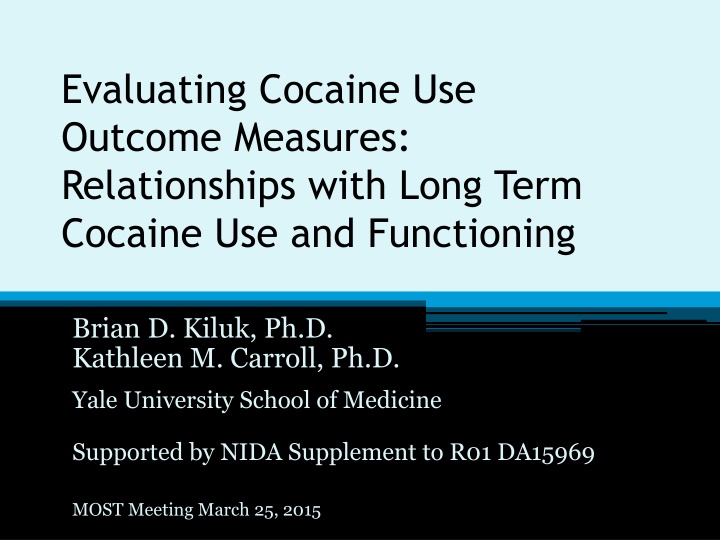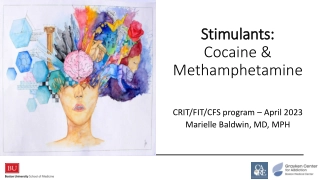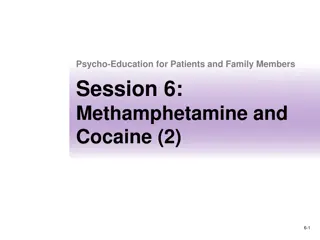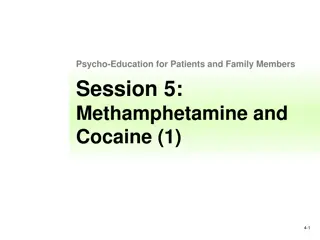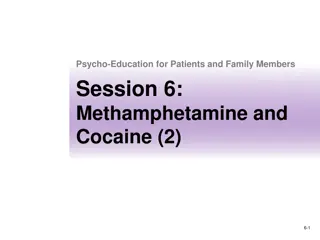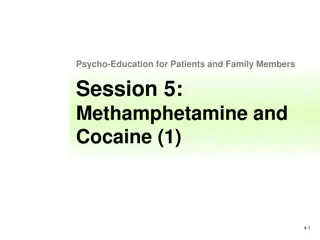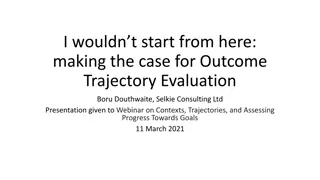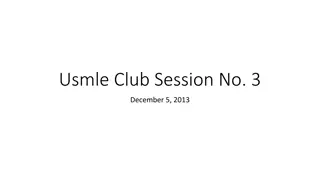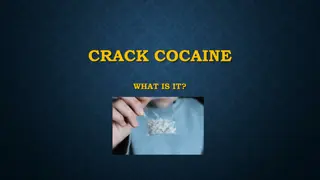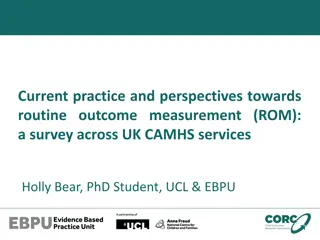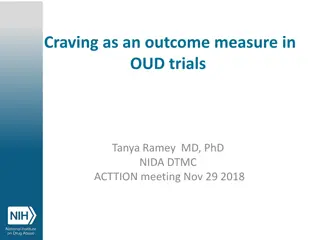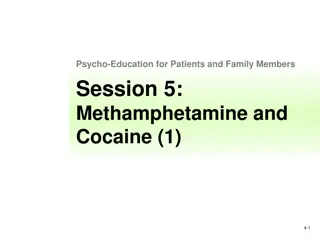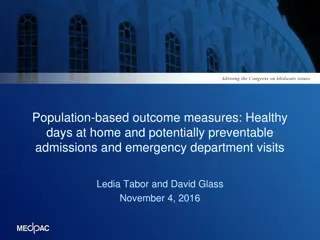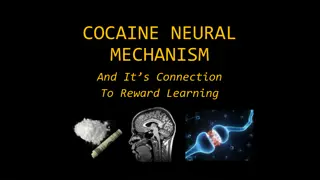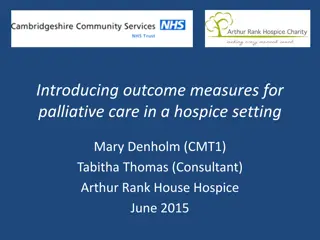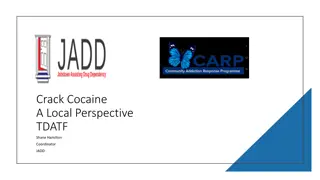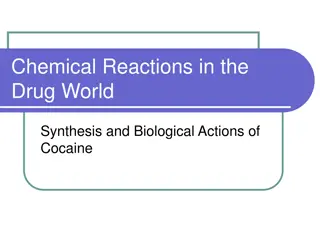Evaluating Cocaine Use Outcome Measures & Relationships with Long-Term Use
This study evaluates 15 treatment outcome measures for cocaine use across multiple randomized controlled trials from 2000 to present. The criteria include sensitivity to medication and behavioral therapies, post-treatment cocaine use, and general functioning. Various studies focus on treatments such as psychotherapy, disulfiram, cognitive-behavioral therapy, and contingency management. The assessment approach involves outpatient treatment, manual-guided behavioral therapies, placebo-controlled medications, urine toxicology screens, and follow-ups up to 1 year. The study aims to identify meaningful indicators of treatment outcomes for cocaine addiction.
Download Presentation

Please find below an Image/Link to download the presentation.
The content on the website is provided AS IS for your information and personal use only. It may not be sold, licensed, or shared on other websites without obtaining consent from the author.If you encounter any issues during the download, it is possible that the publisher has removed the file from their server.
You are allowed to download the files provided on this website for personal or commercial use, subject to the condition that they are used lawfully. All files are the property of their respective owners.
The content on the website is provided AS IS for your information and personal use only. It may not be sold, licensed, or shared on other websites without obtaining consent from the author.
E N D
Presentation Transcript
Evaluating Cocaine Use Outcome Measures: Relationships with Long Term Cocaine Use and Functioning Brian D. Kiluk, Ph.D. Kathleen M. Carroll, Ph.D. Yale University School of Medicine Supported by NIDA Supplement to R01 DA15969 MOST Meeting March 25, 2015
Overview Evaluate 15 candidate cocaine use treatment outcome measures Pooled data across 5 RCTs Criteria Sensitivity to medication effects Sensitivity to behavioral therapies Relationship with post-treatment cocaine use Relationship to measures of general functioning Carroll, Kiluk et al., (2014). Towards empirical identification of a clinically meaningful indicator of treatment outcome for drug addiction: Features of candidate indicators and evaluation of sensitivity to treatment effects and relationship to one year cocaine use follow-up outcomes. Drug and Alcohol Dependence, 137, 3-19.
Multiple cocaine treatment RCTs, 2000-present Study 1 Cocaine-alcohol Carroll, K.M., Nich, C., Ball, S.A., et al. 1998. Treatment of cocaine and alcohol dependence with psychotherapy and disulfiram. Addiction 93, 713-728. Carroll, K.M., Nich, C., Ball, S.A., et al. 2000. One year follow-up of disulfiram and psychotherapy for cocaine-alcohol abusers: Sustained effects of treatment. Addiction 95, 1335-1349. Study 2 M&M Carroll, K.M., Fenton, L.R., Ball, S.A.,et al. 2004. Efficacy of disulfiram and cognitive- behavioral therapy in cocaine-dependent outpatients: A randomized placebo controlled trial. Archives of General Psychiatry 64, 264-272. Study 3 TSF/Disulfiram Carroll, K.M., Eagan, D., Nich, C., et al. 2012,. Efficacy of Twelve Step Facilitation and disulfiram for cocaine-using methadone-maintained individuals. Drug and Alcohol Dependence , 126, 224-231 Study 4 CBT4CBT1 Carroll, K.M., Ball, S.A., Martino, S., et al. 2008. Computer-assisted cognitive-behavioral therapy for addiction. A randomized clinical trial of 'CBT4CBT'. American Journal of Psychiatry 165, 881-888. Carroll, K.M., Ball, S.A., Martino, S., et al. 2009. Enduring effects of a computer- assisted training program for cognitive-behavioral therapy: A six-month follow-up of CBT4CBT. Drug and Alcohol Dependence 100, 178-181 Study 5 CM Disulfiram Carroll, K.M., Nich, C., Petry, N.M., et al, under review. Disulfiram and contingency management to enhance CBT for cocaine dependence: effects on cocaine use and preliminary evidence for interactions with DBH polymorphism.
Common assessment approach 12 weeks outpatient treatment Behavioral therapies manual guided with independent fidelity checks Medications placebo controlled with riboflavin checks 1-3/x weekly urine toxicology screens 1 year follow-up (15 months from randomization) Substance Use Calendar Day by day frequency of cocaine use during entirety of study Average 13% discrepancy from urine results (urine positive, self-report negative) Follow-ups with urine collection at 1, 3, 6, 12 months >80% of the intention to treat sample Addiction Severity Index at each assessment
Common follow-up indicators Mean days of cocaine use 1, 3, 6, and 12 month follow ups via Substance Use Calendar Abstinent throughout full follow-up Composite measure of good outcome Days of employment problems = 0, Days of legal problems = 0, Days of psych problems=0, Days of cocaine use = 0
Study 1 121 cocaine- and alcohol dependent outpatients 12 weeks 1 year follow-up Weekly utox Manual guided, fidelity rated Riboflavin for med compliance Outcomes: CBT, TSF > Clinical management Disulfiram > no med Clinical Mangmt TSF CBT Disulfiram 250 mg/day No medication
Study 2 N=121 cocaine dependent outpatients 12 weeks Utox 1x week 1 year follow-up Manual-guided with fidelity ratings Double blind placebo control, riboflavin CBT IPT Disulfiram Placebo Outcomes CBT>IPT Disulif>placebo
Study 3 N=112 cocaine-dependent methadone maintained patients 12 weeks Utox 3x week 1 year follow-up Manual-guided with fidelity ratings Double blind placebo control, riboflavin TAU TAU + TSF Disulfiram Placebo Outcomes TSF>TAU alone No medication effect
Study 4 N=78 mixed substance users, outpatients, 38 cocaine users. 8 weeks of treatment, 6 month follow-up Utox 2x weekly TAU TAU + CBT4CBT Outcomes CBT4CBT>TAU alone
Study 5 N=99 cocaine-dependent outpatients 12 weeks Utox 3x week 1 year follow-up Manual-guided with fidelity ratings Double blind placebo control CBT CBT+ CM Disulfiram Placebo Outcome: CM+CBT>CBT alone No main effect for disulfiram, interaction with DBH
Overview of trials Medication Behav therapy N for follow- up sample (all > 80%) % % Mean days cocaine use/past 28 14 % not working % criminal justice referred female ethnic minority Disulfiram v no med CBT v TSF v clinical management Study 1: Coc-Alcohol, 91 29% 60% 55% 24% CBT v IPT Disulfiram v placebo Study 2: M&M 108 25 35 14 57 22 Disulfiram v placebo TSF v no TSF Study 3: TSF- Disulifram, 112 41 36 16 46 2 No med CBT4CBT v TAU Study 4: CBT4CBT 38** 47 76 8 80 42 Disuflriam v placebo CM + CBT v CBT Study 5: CM-Dis 85 31 60 14 69 5 TOTAL 434 33 48 13 53 16
Outcomes across trials Design Platform Urine schedule/ % cocaine free Mean % days abstinent during tx % completely abstinent during treatment 6 month follow-up % good outcome composite 1 Coc- Alcohol 2x/ 55% Outpatient Coc+alcohol 3 x 2 RCT 85% 19% 13% 2 M&M 1x/ 68% Outpatient cocaine 2 x 2 RCT 81 12 13 3 TSF Dis 3x/ 18% Methadone cocaine 2 x 2 RCT 60 5 18 4 CBT4CBT Outpatient cocaine subgroup only 2x/ 50% 2 group RCT 82 9 24 5. CM Disulf 3X/ 44% Outpatient cocaine 2 x 2 RCT 76 17 27
Medication effects across indicators No medication n=36 mean or N Placebo n=148 Disulfiram n=212 mean or N sd or % mean or N sd or % sd or % Outcome Indicator F/X2p Tukey/phi Type Disulf, Placebo >No med Days retained in treatment protocol Percent negative cocaine urine specimens 37.5 42.6 32.1 41.1 53.7 37.5 35.6 36.0 58.3 38.9 32.6 36.8 6.26 .00 0.37 .70 C C Maximum consecutive days abstinent 19.5 18.6 19.1 23.4 25.7 26.2 3.2 .04 Disulf > Placebo C No Percent days of abstinence from cocaine Maximum days of continuous abstinence during last two weeks of treatment* Completely abstinent last two weeks of treatment 3 or more weeks of continuous abstinence 2 or more weeks of continuous abstinence 1 or more weeks of continuous abstinence Completely abstinent from cocaine during treatment 83.1 18.0 76.4 25.3 70.9 26.9 5.61 .00 C med>Placebo Disulfiram > Placebo 7.6 4.5 8.9 4.7 4.83 .03 C No med > Disulf, placebo 10 9 15 22 36% 25% 42% 61% 29 61 68 106 24% 41% 46% 72% 75 93 113 158 24% 44% 53% 75% 10.39 .01 4.52 .10 2.86 .24 2.84 .26 D D D D 5 14% 17 10% 29 14% 0.26 .88 D Completed treatment and abstinent in last week 7 19% 35 24% 74 37% 8.27 .02 Disulf > no med D % reduction (28 days prior/days last 4 weeks) 50% reduction in frequency of cocaine use 62.2 9 36.0 25% 60.2 0.54 37.3 37% 52.8 70 39.3 33% 1.78 1.78 .17 .41 C D 75% reduction in cocaine use Report no cocaine use, legal, employment, or psychological problems last 28 days of treatment good outcome 4 11% 28 19% 36 17% 1.25 .54 D 2 17% 19 13% 18 19% 1.18 .55 D
Indicators across behavioral therapies Comparison (1) TSF(2) CBT (3) CM (4) n=195 Mean or n n=97 Mean or n n=105 Mean or n n=37 Mean or n Outcome indicator sd or % sd or % sd or % sd or % p Tukey ns F/ X2 Days retained in treatment protocol 54.2 33.1 56.9 33 51.63 30.86 46.08 34.05 1.13 .34 Proportion cocaine negative urine specimens 1v3, 1v4 2v3, 2v4 .36 .37 .26 .29 .49 .38 .56 .38 8.13 0.00 Maximum consecutive days abstinent 20.1 24.3 23.7 22.97 25.7 23.58 23.76 27.72 1.26 .29 ns Percent days of abstinence .72 .27 .75 .24 .82 .21 .81 .26 4.20 0.01 1v3 Maximum days of continuous abstinence during participant's last two weeks of treatment 8.1 4.7 7.9 4.53 9.35 4.38 10.27 4.63 2.54 0.06 ns Completely abstinent last 2 weeks of treatment 4 v other, 3 v 2 54 33% 24 27% 42 46% 14.00 54% 11.61 .009 3+ weeks of continuous abstinence 74 38% 34 35% 45 43% 27.00 73% 17.85 .00 4 v other 2+ weeks of continuous abstinence 90 46% 40 41% 57 54% 29.00 78% 16.82 .001 4 v other 1+ weeks of continuous abstinence 139 71% 66 68% 73 70% 32.00 71% 4.85 .18 ns Completely abstinent from cocaine during treatment 25 13% 11 11% 16 15% 8.00 24% 3.55 .31 ns Completing treatment and abstinent in last week 56 31% 26 28% 35 37% 11.00 30% 2.15 .54 ns % reduction in frequency of cocaine use (28 days prior/days last 4 weeks) 50% reduction 0.53 0.38 0.58 .39 .65 .37 .62 .32 2.15 .09 ns 60.0 31% 26 27% 38 36% 15.00 41% 3.43 .33 ns 75% reduction 3 v other, 4 v other 23 12% 9 9% 25 24% 12.00 32% 18.12 .00 Good outcome 20 11% 8 12% 5 6% 9.00 24% 8.9 .03 4 v other
Relationship with Post-Treatment Cocaine Use and Functioning Days of Cocaine Use in Follow-Up Month 3 -.06 .23 -.28 .00 -.24 .00 -.37 .00 -.35 .00 Good Functioning Status at Follow-Up Month 1 3 .10 .05 .04 .35 .33 .29 .00 .00 .34 .26 .00 .00 .23 .21 .00 .00 .31 .33 .00 .00 Complete Abstinence in FU Outcome indicator Days retained in treatment protocol 1 6 12 .02 .76 -.16 .01 -.12 .02 -.24 .00 -.21 .00 6 12 .04 .47 .22 .00 .17 .00 .14 .01 .24 .00 r -.12 .01 -.31 .00 -.30 .00 -.39 .00 -.46 .00 -.08 .09 -.30 .00 -.26 .00 -.35 .00 -.30 .00 .05 .33 .33 .00 .30 .00 .19 .00 .32 .00 .08 .12 .25 .00 .24 .00 .18 .00 .19 .00 p r Percent cocaine negative urine specimens Maximum consecutive days of abstinence Percent days of abstinence p r p r p r Maximum days of consecutive abstinence during last two weeks of treatment Completely abstinent last two weeks of treatment p r -.30 .00 -.25 .00 -.19 .00 -.07 .25 .28 .00 .29 .00 .31 .00 .21 .00 .19 .00 p r -.33 .00 -.26 .00 -.27 .00 -.14 .00 -.30 .00 -.26 .00 -.22 .00 -.08 .12 -.28 .00 -.28 .00 -.24 .00 -.11 .03 -.16 .00 -.14 .01 -.10 .05 -.09 .09 .25 .00 .24 .00 .11 .02 .23 .00 .26 .00 .24 .00 .21 .00 .28 .00 .26 .00 .26 .00 .17 .00 .17 .00 .24 .00 .22 .00 .15 .00 .14 .00 .24 .00 .20 .00 .17 .00 .19 .00 3+ weeks of abstinence p r 2+ weeks of abstinence p r 1+ week of abstinence p r Completely abstinent during treatment Completed treatment and abstinent in the last week % reduction in frequency of cocaine use 50% reduction p r -.30 .00 -.32 .00 -.02 .65 -.08 .08 -.20 .00 -.24 .00 -.26 .00 -.01 .76 -.07 .14 -.20 .00 -.22 .00 -.22 .00 .02 .67 -.04 .42 -.15 .00 -.09 .09 -.11 .07 .04 .49 -.01 .92 -.08 .16 .23 .00 .18 .00 -.16 .00 -.11 .02 .29 .00 .22 .00 .24 .00 -.04 .40 -.04 .39 .37 .00 .23 .00 .22 .00 -.05 .30 .00 .94 .28 .00 .19 .00 .17 .00 -.09 .06 -.01 .88 .24 .00 .12 .03 .14 .01 .00 .94 .07 .21 .21 .00 p r p r p r 75% reduction p r Good outcome p
Sensitivity to disulfiram effects Sensitivity to behavioral therapies Relationship with post tx cocaine use Relationship to measures of general functioning/ Outcome Indicator Days retained in treatment protocol X X X X Percent negative cocaine urine specimens X X X Maximum consecutive days abstinent X X X Percent days of abstinence from cocaine Maximum days of continuous abstinence during last two weeks of treatment X X X X X X X Completely abstinent last two weeks of treatment X X X X 3 or more weeks of continuous abstinence X 2 or more weeks of continuous abstinence 1 or more weeks of continuous abstinence Completely abstinent from cocaine during treatment X X Completed treatment and abstinent in last week X % reduction (28 days prior/days last 4 weeks) 50% reduction in cocaine use X 75% reduction in cocaine use X X X Good outcome
Does cocaine abstinence have effect on functional problems? Evaluate the relationship between within-treatment cocaine use and problems in major life areas other than cocaine use (e.g., medical, legal, employment, family/social, psychological) following treatment Latent growth curve model to evaluate within-tx cocaine use on change in global problems over time Kiluk, B.D., Nich, C., Witkiewitz, K., Babuscio, T.A., & Carroll, K.M. (2014). What happens in treatment doesn t stay in treatment: Cocaine abstinence during treatment is associated with fewer problems at follow-up. Journal of Consulting and Clinical Psychology, 82, 619-627.
Global Problems construct Created latent measure of global problems Used longitudinal confirmatory factor analysis to evaluate equivalence of ASI problem subscales over time Used Days of Problems item rather than composite score Examined whether factor structure was metric invariant over time Unconditional latent growth curve modeling used to examine changes in global problems over time Conditional latent growth curve modeling used to examine association between within-tx cocaine use and follow-up levels of global problems over time (controlling for baseline problems)
Latent growth curve model of within-tx cocaine use and change in global problems during follow-up period = .32** = -.17** = - .43** ** p<.001
Summary, so far Existing widely used continuous measures are consistent predictors of cocaine use and good general functioning in follow up: Percent days abstinent, maximum days of consecutive abstinence, percent positive urines, max days abstinence in last 2 weeks Good performance of urine measures and abstinence at termination measures offset by limits to availability of data (80% of samples) Poorer performance for reduction measures, as well as complete abstinence during treatment End of treatment abstinence, 3+ weeks abstinence very consistent predictor of long term cocaine use and functioning, sensitive to effects of medication and behavioral therapies Higher levels of cocaine abstinence during tx associated with fewer problems during follow-up (controlling for baseline level of problems)
